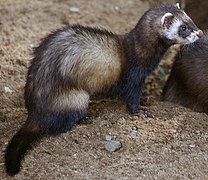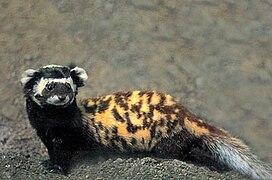Polecat
 Description
Description
Polecat is a common name for several mustelid species in the order Carnivora and subfamilies Ictonychinae[1] and Mustelinae. Polecats do not form a single taxonomic rank (i.e. clade). The name is applied to several species with broad similarities to European polecats, such as having a dark mask-like marking across the face.
In the United States, the term polecat is sometimes applied to the black-footed ferret, a native member of the Mustelinae. In Southern United States dialect, the term polecat is sometimes used as a colloquial nickname for the skunk, which is part of the family Mephitidae.[2]
Despite their common name, polecats are related more closely to dogs than to cats.
Taxonomy
According to the most recent taxonomic scheme proposing eight subfamilies within Mustelidae, polecats are classified as:
Subfamily Ictonychinae
Subfamily Mustelinae
Striped polecat
Steppe polecat
Black-footed ferret, the “American polecat”
European polecat
Marbled polecat
The polecat, scientifically known as Mustela putorius, is a small yet resilient member of the Mustelidae family, which also includes weasels, otters, and ferrets. Often mistaken for its close relative, the ferret, the polecat possesses distinctive characteristics and behaviors that set it apart as a fascinating and adaptable predator.
Native to Europe and parts of Asia, the polecat is characterized by its sleek body, short legs, and distinctive fur pattern. Its fur is typically dark brown to black in color, with a lighter underbelly and a conspicuous mask of white fur that extends from its muzzle to the sides of its head, giving it a distinctive appearance. This mask serves as camouflage, helping the polecat blend into its surroundings as it prowls through its woodland and grassland habitats in search of prey.
Despite its diminutive size, the polecat is a formidable predator with a diverse diet. It primarily preys on small mammals such as rabbits, rodents, and birds, using its sharp claws and teeth to dispatch its prey swiftly and efficiently. However, the polecat is also known to opportunistically feed on insects, amphibians, and even fruits and berries when other food sources are scarce. This adaptability and versatility allow the polecat to thrive in a variety of habitats, from rural farmland to suburban areas.
One of the most intriguing aspects of the polecat's behavior is its mating rituals and social structure. Like many other members of the Mustelidae family, polecats are solitary animals for much of the year, only coming together during the breeding season, which typically occurs in late winter or early spring. During this time, males compete fiercely for the attention of females, engaging in ritualized displays of dominance and aggression. Once mating is complete, the female gives birth to a litter of kits, which she raises in a burrow or den hidden among dense vegetation.
Despite its adaptability and resilience, the polecat faces numerous threats to its survival. Habitat loss and fragmentation due to urbanization, agricultural expansion, and infrastructure development have resulted in the decline of polecat populations across much of its range. In addition, the polecat is often persecuted by humans due to its reputation as a poultry thief and predator of game birds, leading to trapping, poisoning, and other forms of control measures.
To address these threats and ensure the long-term survival of the polecat, concerted conservation efforts are needed. These efforts should focus on habitat preservation and restoration, as well as the implementation of measures to reduce human-wildlife conflict and promote coexistence. Educating the public about the importance of polecats in maintaining healthy ecosystems and controlling pest populations can also help foster a greater appreciation for these enigmatic predators.
Furthermore, research into the ecology, behavior, and population dynamics of polecats is essential for developing effective conservation strategies. By gaining a deeper understanding of the factors influencing polecat populations and their interactions with their environment, conservationists can tailor their efforts to maximize impact and ensure the continued existence of this fascinating species for generations to come.

In conclusion, the polecat is a captivating and resilient predator that plays a vital role in maintaining the balance of ecosystems across Europe and Asia. Its adaptability, hunting prowess, and distinctive appearance make it a fascinating subject of study and a valuable asset to the natural world. Through collaborative conservation efforts and public awareness, we can secure a brighter future for the polecat and ensure that it continues to thrive in the wild for years to come.
 Description
Description



Comments
Post a Comment